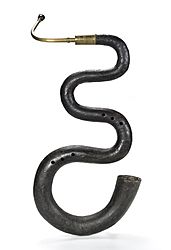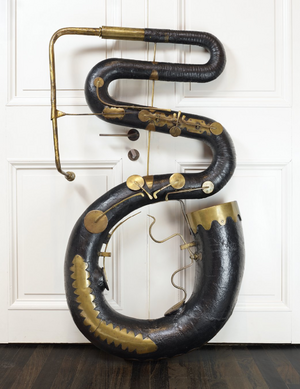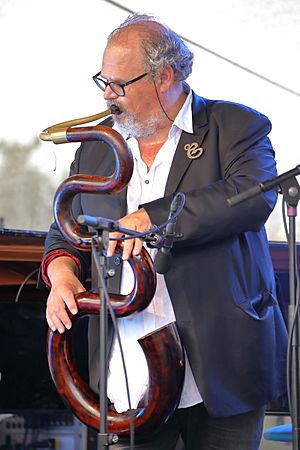Serpent (instrument) facts for kids

Serpent, late 18th century Italy. Civic Museum of Modena
|
|
| Brass instrument | |
|---|---|
| Other names |
|
| Classification | |
| Hornbostel–Sachs classification | 423.21 (aerophone sounded by lip vibration with keys) |
| Developed | Late 16th century |
| Playing range | |
|
<score lang="lilypond">
Range of the serpent; notes below C₂ are obtained with the embouchure{ \new Staff \with { \remove "Time_signature_engraver" } \clef bass \key c \major \cadenzaOn \tweak font-size #-2 a,,1 ^ "poss." c,1 \glissando c1 } </score> |
|
| Related instruments | |
| Musicians | |
|
|
| Builders | |
|
|
The serpent is a special kind of brass instrument that makes low sounds. It was invented a long time ago, during the Renaissance period. Even though it's a brass instrument, it's made from wood and covered with leather.
The serpent gets its name because it's shaped like a snake! It has a trombone-like mouthpiece and tone holes, which are like the holes on a woodwind instrument. It's a distant ancestor of the tuba. The serpent was used in music from the 1600s to the early 1800s.
The sound of a serpent is a mix between a bassoon and a euphonium. Players usually sit down and hold the instrument between their knees.
Contents
How is the Serpent Made?
The serpent is usually made from strong woods like walnut, maple, or cherry. It's built from several curved wooden pieces. Each piece is made by gluing two hollow halves together. Then, these pieces are joined and covered with dark leather.
The instrument uses a mouthpiece similar in size to a tenor trombone mouthpiece. This mouthpiece fits into a small metal tube called a bocal. The serpent has six tone holes, which are played with the fingers of both hands. Older serpents didn't have keys, but newer ones added keys to help with playing notes better and extending the range.
Today, some instrument makers create new serpents. They use modern materials and techniques, like 3D printing, to make them sound even better. One maker, Stephan Berger, even makes a light serpent from carbon fibre.
The Giant Contrabass Serpent
Imagine a serpent that's twice as big! That's the contrabass serpent, sometimes called the anaconda. It plays notes one octave lower than a regular serpent. The first one was built around 1840 in England.
In the 1990s, a maker named Christopher Monk built two more contrabass serpents. One of these is now owned by a famous trombonist and serpent player, Douglas Yeo.
The Serpent's History
No one is completely sure when or where the serpent was first invented. Some people think it was created in 1590 by a clergyman named Edmé Guillaume in France. Others believe it came from large, S-shaped bass cornetts used in Italy in the 1500s.
What we do know is that the serpent was used in France from the early 1600s. It helped make the bass parts of church choirs sound stronger. This original serpent was known as the serpent ordinaire or serpent d'église, meaning "ordinary serpent" or "church serpent."
Around the mid-1700s, the serpent started to be used in smaller music groups and later in orchestras. The famous composer Mozart even used two serpents in his 1771 opera Ascanio in Alba.
Serpents for Military Bands
Towards the end of the 1700s, the serpent became popular in military bands. This led to new designs that were easier for musicians to play while marching or riding horses.
In England, a special military serpent was made. It was more compact and had extra keys to help it play better. It also had metal braces to make it stronger.
In France, a serpent militaire was developed. This one had its tubes arranged vertically, with the bell pointing upwards, a bit like a tenor saxophone.
Upright Serpents and Bass Horns
In the early 1800s, several new versions of the serpent appeared. These were called upright serpents or bass horns. They still had the same fingering and six tone holes as the original serpent, but their shape was more like a bassoon, with straight tubes joined together.
The Russian Bassoon
One of the first upright serpents was called the basson russe, or "Russian bassoon." But it wasn't Russian, and it wasn't a bassoon! The name might have come from "Prussian bassoon" because the Prussian army used them. These instruments often had cool animal-shaped bells, like a dragon or serpent head.
The English Bass Horn
The English bass horn was invented in London in 1799. It was made entirely of metal and looked a bit like a watering can. However, the composer Felix Mendelssohn liked its sound and wrote music for it in some of his works. This instrument was popular in bands in Britain and Ireland. It also influenced the creation of other instruments like the ophicleide and later the tuba.
Early Cimbasso
In Italy, the serpent was called serpentone in operas from the early 1800s. It was later replaced by the cimbasso. This term referred to different instruments over time, starting with an upright serpent, then the ophicleide, and eventually a type of tuba.
Other Upright Serpents
In 1823, the serpent Forveille was invented in Paris. It was an upright serpent with a larger bell, influenced by the new ophicleide. It became popular because it sounded better. Another invention was the ophimonocleide in 1828. It helped fix a problem with the serpent's difficult B notes.
The time of upright serpents was short, lasting only the first half of the 1800s. They were replaced by the ophicleide and later by valved brass instruments like the tuba.
The Serpent's Comeback
By 1900, the serpent had almost disappeared from music. But since the mid-1900s, people have become interested in it again!
An English historian named Christopher Monk started building replica serpents. In 1968, he found a way to make them more cheaply, which helped more people get interested. In 1976, he formed the London Serpent Trio, which played new and old music for the serpent all over Europe and North America.
At the same time in France, Bernard Fourtet and jazz musician Michel Godard also helped bring the serpent back. They even started a school for young serpent players.
How High and Low Can a Serpent Play?
\new Staff \with { \remove "Time_signature_engraver" } \clef bass \key c \major \cadenzaOn \tweak font-size #-2 a,,1 ^ "poss." c,1 \glissando c1
}</score>The serpent's range can change depending on the instrument and the player. But generally, it can play three octaves, from a low C to a high C. Good players can even make it play lower notes by using their embouchure (how they shape their lips on the mouthpiece).
Music for the Serpent
The serpent has appeared in modern music, including film scores. For example, American film composer Bernard Herrmann used a serpent in his movies White Witch Doctor (1953) and Journey to the Center of the Earth (1959). Jerry Goldsmith also used it in his score for Alien (1979).
In jazz music, the French musician Michel Godard has used the serpent in his performances.
New pieces have been written for the serpent too. In 1987, English composer Simon Proctor wrote a concerto for serpent and orchestra. It was first played in 1989. Another funny piece, "O Serpent," was written by Peter Shickele for the London Serpent Trio.
Famous Serpent Players
- Clifford Bevan: A music historian and member of the London Serpent Trio.
- Bernard Fourtet: A French expert in early music.
- Michel Godard: A jazz musician who plays the tuba and serpent.
- Phil Humphries: A member of the London Serpent Trio.
- Alan Lumsden: A member of the London Serpent Trio.
- Andrew van der Beek: A member of the London Serpent Trio.
- Steve Wick: A tuba professor and member of the London Serpent Trio.
- Douglas Yeo: A retired bass trombonist from the Boston Symphony Orchestra who also plays the serpent.
See also
 In Spanish: Serpentón para niños
In Spanish: Serpentón para niños










